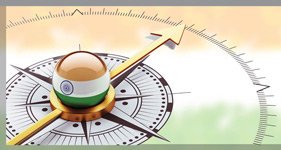In the aftermath of yet another brazen terror strike, India’s blood boils — and rightly so. The public demands justice. The strategic community calls for calibrated retaliation. The political leadership weighs its options. And the armed forces stand ready. But amidst this fury, a quieter question demands our attention: What will it truly cost us to go to war with Pakistan again?
As a nation marching towards its Viksit Bharat 2047 vision — aiming to become a $30 trillion developed economy — India must now confront a bitter strategic truth: full-scale war is no longer a trophy of national honour; it is a trap. This is not an argument against justice, deterrence, or strength. It is an argument for smart statecraft in an age where war can derail not just economies but destinies as well.
What Would a War Look Like Today?
Let us consider three possible trajectories in the event of a military escalation with Pakistan with figures just a wild guess, which could vary with war effort and intensity:
Scenario 1: A Two-Week High-Intensity Retaliatory War
This would mirror a more muscular version of Balakot or Kargil — a rapid but shallow penetration strike campaign along LoC combining air force precision strikes, artillery barrages, and naval blockades.
- Economic hit: ₹4.5–₹5.5 lakh crore ($54–66 billion) through capital outflows, disrupted trade, oil price spikes, and stock market bloodletting.
- Casualties: Up to 8,000 soldiers and 3,000 civilians.
- Daily cost: ₹32,000 crore (~$3.8 billion).
- Defence costs: ₹1.5 lakh crore in replenishment of high-value munitions and fuel.
- Strategic delay: Viksit Bharat programmes — green hydrogen, chip fabs, health digitisation — may be delayed by 12–18 months.
A two-week high-intensity retaliatory war, a more muscular version of Balakot or Kargil – a rapid but shallow penetration strike campaign along LoC combining air force precision strikes, artillery barrages, and naval blockades – would cost India ₹4.5–₹5.5 lakh crore ($54–66 billion) economic hit, in addition to casualties up to 8,000 soldiers and 3,000 civilians
Scenario 2: A Full-Fledged Four-Week War
A nightmare scenario where deterrence collapses and India is dragged into large-scale combat across multiple fronts.
- Total economic damage: ₹9–11 lakh crore ($108–132 billion), with 1.5–2% GDP contraction.
- Casualties: 15,000+ troops, 60,000 wounded, thousands of civilian deaths.
- Daily cost: ~₹29,000 crore.
- Reconstruction: ₹2 lakh crore needed for post-conflict rebuilding of border infrastructure, homes, and schools.
- Strategic disruption: India could lose 3–5 years of progress across sectors — clean tech, education, AI, climate resilience.
Scenario 3: A Decade of Low-Level Hostilities
The most likely trajectory: a persistent grey-zone war with Pakistan using drones, narcotics, proxy groups, covert operations, cyberattacks, and border skirmishes.
- Cumulative cost (2025–2035): ₹1.2–1.5 lakh crore (~$14–18 billion).
- Human toll: 4,000 troops and 1,000 civilians.
- Opportunity cost: Slower development of Border States; investor wariness; erosion of public morale.
The Other Side of the Ledger: Pakistan’s Cost of War
While India’s economic base offers resilience, Pakistan’s fragility makes it dangerously vulnerable to catastrophic outcomes.
- Economic Collapse Risk: Pakistan’s economy, already under IMF surveillance and with foreign reserves hovering below $4 billion, cannot absorb the shock of even a limited war.
- Estimated war cost: $15–20 billion for a 2-week war; ~$40–50 billion for 4 weeks.
- GDP contraction risk: 3–4%, leading to recession and sovereign default.
- Military Degradation: Sustained conflict would deplete stocks of missiles, tanks, and fighter jets in under three weeks. Unlike India, replenishment from allies like China may be delayed or conditional.
- Diplomatic Isolation: Renewed aggression risks blacklisting by FATF, stricter US/EU sanctions, and diplomatic rupture with Gulf States, jeopardising remittances (over $31 billion/year).
- Civil Unrest and Fragmentation: Pakistan’s provinces (Baluchistan, Sindh, Gilgit-Baltistan) are simmering. War could be the trigger for ethnic uprisings and internal instability.
- Post-War Political Collapse: History shows (1971, Kargil) that Pakistani military misadventures often destabilise civilian regimes and worsen institutional breakdown.
In short, Pakistan cannot afford a war. And that very desperation may push it towards asymmetric escalation — cyberattacks, proxy terror, or nuclear brinkmanship. That makes strategic containment even more critical for India.
India must rise above the post-Pahalgam rage – not with weakness, but wisdom. The goal should be deterrence through technology, economic heft, and perception warfare, not battlefield attrition. There is a need to build de-escalation backdoors even during a front-door fire and revive retired military-diplomatic taskforces for crisis backchanneling
What History Cautions Us
India’s past military engagements based on open-source approx. Guesstimate data offer sobering insights:
- Kargil (1999): ₹25,000 crore; 527 soldiers martyred. The war was won but at a steep diplomatic cost.
- Uri Surgical Strikes (2016): ₹200 crore; tactically sound, strategically limited.
- Balakot (2019): ₹400 crore for operations, with ripple effects costing ₹2,000 crore. Sparked an aerial standoff and pilot capture.
- Galwan (2020): Over ₹20,000 crore for mountain infrastructure. A new defensive posture now costs India ₹12,000 crore/year in deployment alone.
The Invisible Costs of War
- Economic Disruption: War spooks markets, raises borrowing costs, depreciates currency, and slows investor confidence. Just rumours of escalation have previously wiped ₹7–10 lakh crore off the Nifty and Sensex. Exports stall. Oil imports surge. Insurance premiums rise.
- Human and Social Trauma: War doesn’t end when guns fall silent. It scars families, displaces lakhs, and impacts society. War reconstruction cost poses another challenge.
- Political Polarisation: Initial unity often gives way to jingoism, censorship, and communal flare-ups. The long-term cost is a fractured polity where dissent becomes “anti-national.”
- Strategic Setback: India’s Viksit Bharat blueprint depends on uninterrupted policy and infrastructure cycles. War diverts funds, attention, and civil service bandwidth away from reform.
The Path Ahead: Deterrence without Destruction
India must now rise above the post-Pahalgam rage — not with weakness, but with wisdom. The goal should be deterrence through technology, economic heft, and perception warfare, not battlefield attrition.
Let Pakistan fall on its own sword of instability and let India rise by restraint and transformation because, in this conflict, the true victory is not over Pakistan; instead, it is to achieve the objective of a developed and inclusive country. The decision rests with those in power whom we trust are most empowered to shape the future of the nation
Strategic Recommendations
- Multi-Domain Deterrence: Make retaliation asymmetric — not tit-for-tat, but time-and-domain fluid. Think economy, technology, diplomacy, and perception.
- Precision Over Projection: Use the non-contact force — cyber ops, drones, AI-led surveillance, and covert sabotage — to exact costs without conventional war.
- Economic Sanctions Warfare: Use FATF diplomacy, SWIFT exclusion campaigns, and grey listing pressure to bankrupt Pakistan’s asymmetric capacity.
- Strategic Communications: Shape international and domestic narratives through real-time media cells and counter-disinformation.
- Permanent War Resilience Fund: Create a ₹1 lakh crore pool under the Finance Ministry for reconstruction and counter-shock measures.
- Infrastructure for Dual Use: National highways, bridges, and tunnels must serve civilian prosperity and military exigency.
- Track II Channels: Build de-escalation backdoors even during front-door fire. Revive retired military-diplomatic taskforces for crisis backchanneling.
- De-weaponise Public Discourse: Prevent internal communalisation of external conflict. National unity must not become a tool for political silencing.
Final Thoughts: War is Not Just About Cost — It’s a Strategic Choice
India’s strength is undeniable. It has demonstrated precision, resolve, and readiness. But true strength lies in knowing when not to fight and when to unleash its military power. In 2025, India’s greatest weapon is not a BRAHMOS or a Rafale — but a vision that will outlast its adversaries: Viksit Bharat.
In the wake of Pahalgam, it’s easy to demand blood for blood. But nations are not built on retribution — they are built on vision. And India’s vision — Viksit Bharat — is incompatible with high-cost, high-risk warfare.
Let Pakistan fall on its own sword of instability. Let India rise by restraint, deterrence, and transformation. Because in this conflict, the true victory is not over Pakistan — it is to achieve the objective of an inclusive Viksit Bharat. The decision of course rests with those in power whom we trust are most empowered to shape the future of the nation.
The author, a PVSM, AVSM, VSM has had an illustrious career spanning nearly four decades. A distinguished Armoured Corps officer, he has served in various prestigious staff and command appointments including Commander Independent Armoured Brigade, ADG PP, GOC Armoured Division and GOC Strike 1. The officer retired as DG Mechanised Forces in December 2017 during which he was the architect to initiate process for reintroduction of Light Tank and Chairman on the study on C5ISR for Indian Army. Subsequently he was Consultant MoD/OFB from 2018 to 2020. He is also a reputed defence analyst, a motivational speaker and prolific writer on matters of military, defence technology and national security. The views expressed are personal and do not necessarily carry the views of Raksha Anirveda
















